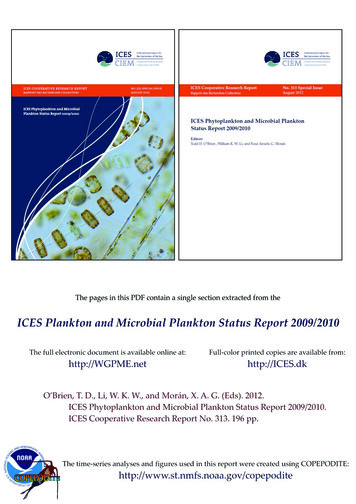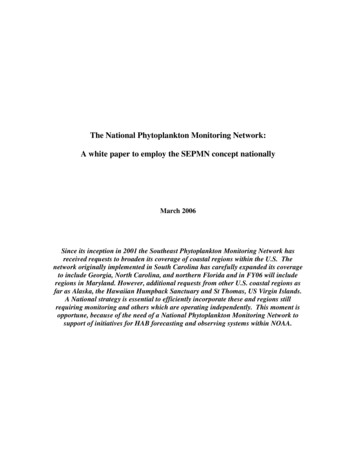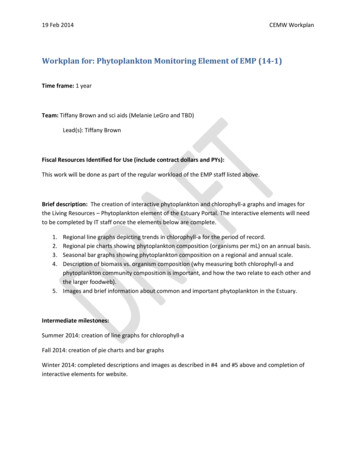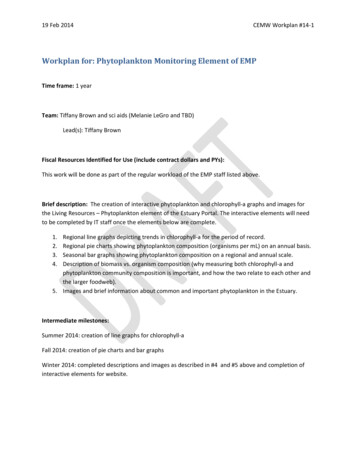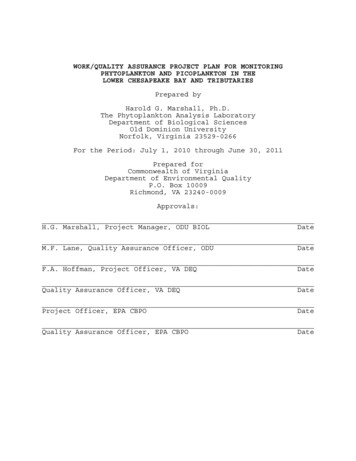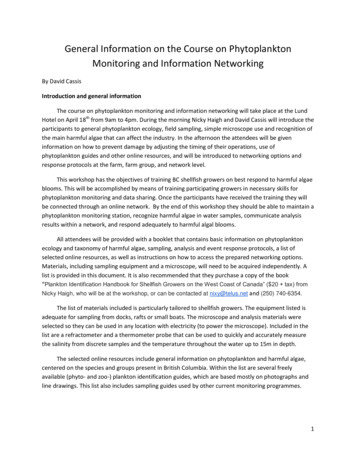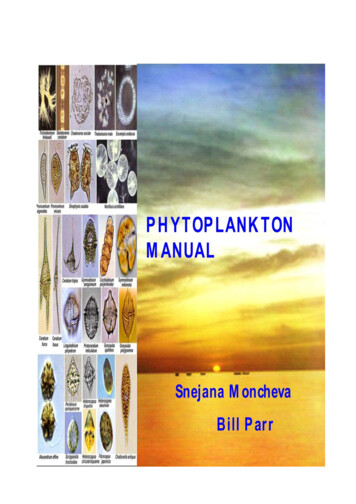
Transcription
Manual for Phytoplankton Sampling and Analysis in theBlack SeaDr. Snejana MonchevaInstitute of Oceanology, BulgarianAcademy of Sciences,Varna, 9000,P.O.Box 152BulgariaDr. Bill ParrUNDP-GEF Black Sea EcosystemRecovery ProjectDolmabahce Sarayi, II. HareketKosku 80680 Besiktas,Istanbul - TURKEYUpdated June 20102
Table of Contents1.INTRODUCTION. 5Basic documents used .Phytoplankton – definition and rationale .The main objectives of phytoplankton community analysis .Phytoplankton communities in the Black Sea .2.SAMPLING . 92.1Site selection.2.2Depth .2.3Frequency and seasonality .2.4Algal Blooms .2.4.1Phytoplankton bloom detection in the field.2.4.2Phytoplankton bloom measures.2.4.3Evaluation forms .2.5Equipment. 112.6Methodology.2.6.1Qualitative sampling .2.6.2Quantitative sampling.3.SAMPLE PRESERVATION AND STORAGE. 143.1Fixatives/preservatives .3.2Advantages and disadvantages of formaldehyde.3.2.1Advantages.3.2.2Disadvantages .3.3Advantages and disadvantages of Lugol’s.3.3.1Advantages.3.3.2Disadvantages .3.4Sample Storage .3.4.1Living samples.3.4.2Preserved samples .4.PHYTOPLANKTON ENUMERATION AND DENSITIES. 184.1Equipment.4.2Sub-sample preparation.4.2.1Sample homogenisation .4.3Cell counts using an inverted microscope .4.3.1Surface water removal.4.3.2Filtration .4.3.3Settling chambers.4.2.3Counting procedure .4.4Cell counts using a conventional light compound microscope .4.4.1Surface water removal.4.4.2Filter-transfer-freeze methodology .4.4.3Centrifugation .4.5Recording the number of algal cells.4.6Density calculations.5.SEMI-QUANTITATIVE ANALYSIS OF PHYTOPIANKTON SAMPLES. 321.11.21.31.4
Inverted micoscope .Conventional light compound microscope.6.TAXONOMIC IDENTIFICATION . 336.1Introduction .6.2Identification books in use within Black sea countries.6.3Additional references of recent taxonomic developments .7.BIOMASS DETERMINATION . 397.1Diatoms.7.2Calculation of a cell’s reference biovolume .8.RECORDING DATA. 41418.1Bench Sheets .9.PHYTOPLANKTON-RELATED ENVIRONMENTAL STATUSINDICATORS. 439.1Introduction .9.2 Black Sea-specific phytoplankton-related environmental statusindicators .10.QUALITY CONTROL AND QUALITY ASSURANCE (QC/QA) . 4510.1 Introduction .10.2 Equipment.10.3 Sampling protocol .10.4 Sample preservation .10.5 Sub-sampling – validation of homogenization .10.6 Sample analysis .10.6.1 Biovolume/biomass estimation.10.6.2 Phytoplankton enumeration.10.6.3 Taxonomy.10.6.4 Re-analysis .10.6.5 Training and inter-laboratory comparability testing .10.6.6 Repeatability and reproducibility.10.6.7 Uncertainty.10.7 Reporting/data storage.Annex A. STANDARDISED LIST OF BLACK SEA PHYTOPLANKTON TAXAAND REFERENCE BIOVOLUMES . 49Annex B. CONTROL CHARTS FOR BIOLOGICAL MEASUREMENTS. 56Annex C. MEASUREMENT UNCERTAINTY . 58Annex D. LIST OFPARTICIPANTS 6211. REFERENCES CITED IN THE MANUAL . 645.15.24
This document is intended for use as a guide to harmonize the procedures among the differentlabs in the Black Sea countries for phytoplankton monitoring. The methods for phytoplanktonmicroscope analysis refer to inverted and light microscope. Methods for analyzing autotrophicpicoplankton are not included in this manual.The first edition has been finalized during the Plankton Workshop, held in Odessa between 1519 August, 2005 under the GEF/UNDP Black Sea Ecosystem Recovery Project (BSERP)RER/01/G33/A/1G/31, attended by representatives of all Black Sea countries.The developers of the checklist software areOleksandra Sergeyeva, Kseniia Skuratova IBSS,Sebastopol, UkraineThis updated edition has been discussed and contributed by the participants of the PhytoplanktonWorkshop, held in Istanbul between 21-23 June 2010, organized by the Black Sea Commissionfor the protection of the Black Sea against pollution, under the UP-GRADE Black Sea ScenePtoject, FP7 , No 226592, List of participants is presented in Annex D-1.
1.INTRODUCTION1.1Basic documents usedThis manual is based on the contents of other phytoplankton manuals and documents, as well asexperience from within the Black Sea Region itself. The following reports and documents havebeen of particular help in compiling this manual: HELCOM Manual Frame.htm). Intergovernmental Oceanographic Commission of UNESCO. 2010. Karlson, B.,Cusack, C. and Bresnan, E. (editors). Microscopic and molecular methods forquantitative phytoplankton analysis. Paris, UNESCO. (IOC Manuals and Guides, no. 55.)(IOC/2010/MG/55), 110 p. Standard Operating Procedures for Algae and Aquatic Plant Sampling and AnalysisNorth Carolina Department of Environment and Natural Resources Division of WaterQuality January 2003 (JAN-03) Version Protocol for Monitoring Phytoplankton. A report by the marine biodiversity monitoring committee (Atlantic maritime ecologicalscience cooperative, Huntsman marine science center) to the ecological monitoring andassessment network of environment Canada by Jennifer L. Martin. The EMANEcosystem Monitoring Protocols and the Community-Based Monitoring Protocols forMarine and estuarine ecosystems, Canada. Phytoplankton guild sampling, preservation and laboratory analysis (prepared by MarinaCabrini, Laboratorio di Biologia Marina, via A. Piccard 54, 34010 Trieste, for a team ofEuropean phytoplankton experts working on the project TWReference-net). Guide to UK Coastal Planktonic Ciliates 2001 DJS Montagnes, University ofLiverpool http://www.liv.ac.uk/ciliate/. REPORT OF THE ICES/HELCOM Steering Group on Quality Assurance of BiologicalMeasurements (SGQAB) in the Baltic Sea ICES Headquarters, Copenhagen 25–28February 2003 Conseil International pour l’Exploration de la Mer, Palægade 2–4 DK–1261 Copenhagen K Denmark. ICES SGQAB REPORT 2005ACME:06 Ref. C, E, HICES/HELCOM Steering Group onQuality Assurance of Biological Measurements in the Baltic SeaICES Headquarters22 –25 February 2005.5
1.2ISO/IEC 17025. General requirements for the competence of testing and calibrationlaboratories and prEN 15204 (under Approval: 2005-11): Water quality - Guidancestandard for the routine analysis of phytoplankton abundance and composition usinginverted microscopy (Utermöhl technique).Phytoplankton – definition and rationaleThe largest plant community in the oceans are the free-drifting, microscopic phytoplankton.These single celled organisms use solar energy by photosynthesis to survive. Though normallyexisting in solitary form, they may form large chains or spherical shaped colonies, some largeenough to see with the naked eye. Despite their small individual size, Phytoplankton are ofenormous importance in the aquatic food chain creating a food source for a variety of organisms,fish and shellfish which in turn provide a food source for larger animals. In addition, thephytoplankton provide most of the oxygen we breathe, and fossilised phytoplankton areassociated with deposits of oil and benthic deposits (sapropell in the Black Sea).Microalgal cells can range in size from less than 1 mm to greater than 1 000 µm, and in somecases can multiply to more than one million cells per liter during a high peak bloom. Thephytoplankton evolved into a diverse group of photosynthetic organisms that are divided intocategories according to size: Microplankton - 20-200 µm.Nanoplankton - 10-20 µm.Ultraplankton - 2-10 µm.Picoplankton less than 2 µm.Picoplankton and ultraplankton tend to be more common in the open ocean than the coastalwaters, whereas the larger nanoplankton and microplankton, such as diatoms and dinoflagellates,tend to dominate coastal waters.Phytoplankton is responsive to the physical and chemical conditions in the aquatic environment.Sometimes their rapid reproduction causes nuisance growths or blooms. Algal blooms havedramatic effects on water chemistry, most notably pH and dissolved oxygen (DO). When algaeremove carbon dioxide during photosynthesis they raise the pH by increasing the level ofhydroxide. The opposite reaction occurs during respiration when carbon dioxide is producedlowering hydroxide and lowering the pH.Microscopic algae are a concern for the water quality and ecosystem health. They can cause tasteand odor problems, water discoloration, or form large mats that can interfere with boating,swimming, and fishing.Reasons for the importance of phytoplankton monitoring when assessing the environmentalstatus and biodiversity of marine ecosystems include: Much of our information on photosynthesis, nutritional requirements, roles of vitamins,and studies of protoplasm comes from studies of algal physiology.6
Algae play an important role in the production of oxygen and other organic materials.They serve in the food chain as a food source for species such as protozoa, rotifers,copepods, cladocerans, euphausiids, clams, mussels, various fish (such as herring) andeven some whales.Algae serve as the first step in the system of energy transfer through aquatic food webs.All aquatic animals in both fresh and salt water require these small plants to maintaintheir existence.There is a growing speculation that the occurrences and blooms of phytoplankton incoastal waters are increasing world wide, especially those that have negative effects.Algae are more and more becoming a great biotic indicator of environmental changes,and/or human induced alterations.Marine environmental policy has increased in importance and a number of directives has beendeveloped to monitor water quality. The Water Framework Directive (WFD) uses phytoplanktonas one of the ecosystem components required to monitor the quality status of marine andfreshwater bodies. Phytoplankton is also a required biological component of the EU MarineStrategy Framework Directive, devised to protect and conserve the marine environment. TheseInternational Maritime Organization (IMO) adopted the Ballast Water Convention in 2004although it has not yet been ratified. This convention includes a ballast water discharge standardwhereby ships will be required to treat or manage ballast water to ensure that no more than 10organisms per mL in the size category 10 µm - 50 µm and no more than 10 organisms per m3 50 µm are discharged.1.3The main objectives of phytoplankton community analysisAnalysis of phytoplankton species composition abundance and biomass is carried out for thefollowing purposes: 1.4To describe temporal trends in phytoplankton species composition, their abundance,biomass and abundance of blooms.To describe spatial distribution of phytoplankton species, their abundance, biomass andblooms.To identify key phytoplankton species (e.g. dominating, harmful and indicator species).Phytoplankton communities in the Black SeaPhytoplankton research in the Black Sea date back to the end of XIX beginning of XXcentury. The extensive investigations on phytoplankton biodiversity, community structure andtime-spatial variability (see national biodiversity reports- Konsulov ,1998, Öztürk , 1998,Petranu,1998, Zaitsev & Alexandrov, 1998, Komakhidze & Mazmanidi, 1998) and thereferences there in) conducted at basin-wide scale reveal that the specific features of the BlackSea, its geographical location in the temperate zone, hydrology and nutrient regime determine toa great extent the natural pattern of phytoplankton dynamics. Originally a highly productive seawith an intensive winter-spring maximum and less intensive autumn peak of phytoplanktonproliferation attributed to the natural variability of the ecosystem (Bologa et al. 1984, Mikaelyan,1997). In summer due to nutrients depletion related to the water stratification the phytoplankton7
biomass is maintained low. The succession of phytoplankton communities follows normally thesequence small diatoms- large diatoms-dinoflagellates-diatoms, with less representatives ofsilicoflagelates, coccolithophores and xanthophytes (Bodeanu, 1989).During the early sixty the usual diatoms/dinoflagellates biomass ratio in spring was10:1(Bodeanu et al., 1997) in contrast to 1970-1990 when frequent late-spring and summerphytoplankton blooms have been recorded, dominated preferentially by fast growing smallmicroalgae, that altered the main taxonomic groups ratio to 1:7. An increase of the share ofopportunistic species was well documented and a number of “exotic” species proliferating in theBlack Sea basin (Gomoiu et al., 2001, Mihnea, 1997, Nesterova, 2001, Zaitsev & Öztürk, 2001and the references there in, Moncheva, Kamburska, 2002.)There is a general agreement that the Black Sea ecosystem evolution in relation toanthropogenic pressure could be relatively subdivided into reference (pristine) period (19541973) and a period of progressive anthropogenic pressure (1974-1993) featured by alteration ofphytoplankton communities structure and function (Vinogradov et al., 1992, Finenko et al., 2001,Churilova et al, 2002, Stelmach et al., 2002, Yunev et al., 2002) and related ecosystemdeterioration effects (anoxia, decreased water transparency, mass mortalities etc.- Mee, Mihnea,2002, Zaitzev, Mamaev, 1997).The reported changes during the late 90ies and the recent period (such as reduced amplitude ofseasonal oscillations, a decrease of phytoplankton monospecific blooms and their critical levelsattained, especially in summer, the increased dominance of diatoms, the shift of the seasonalsuccession to the Black Sea ecosystem natural cycle) manifest some signatures of recoveryrelated to the reduction of the land-based nutrient load into the basin. The instability of this trendhowever questioned the role of anthropogenic eutrophication as a single driving force, in favourof “top-down” and climatic control (Yunev et al, 2002, Oguz et al., 2002, Moncheva et al.,2001). A comprehensive overview of the recent trends in phytoplankton biodiversity and growthpatterns at basin-wide scale is included in. State of the Environment of the Black Sea (20012006/7), the BSC, 2008.8
2.SAMPLING2.1Site selectionThe sampling design originally depends on the purpose of the monitoring program and theavailable resources.Initial sampling sites are dependent on water exchange, depth, water column stability, proximityto land-based sources of pollution. There should also be a sampling location near fresh waterexchange, or river run-off ensuring all types of predefined water bodies (sensu WFD) e.g.coastal, transitional and offshore sites are included. In order to reflect the Black Sea specificphysical oceanography an on-offshore transect of stations within the 12 miles zone isrecommended. Sites such as bridges, wharfs, and intertidal areas are not suitable for sampling.The availability of long-term data (monitoring stations) is an advantage.2.2DepthThe sampling depths are determined depending on the vertical profile of the water column and inaddition to the standard sampling levels (surface-1m under the surface, 3-5m, 10m, 25m, 50m,75m and bottom sample – 1m above the bottom) sampling at the vertical gradients is extremelyimportant (thermocline, pycnocline, nutricline and the chl.a subsurface maximum). Therefore anin situ fluorometer attached to the CTD is strongly recommended.Vertical profile of water column as inferred from a CTD cast equipped with a n in situfluorimeter2.3Frequency and seasonalityAs phytoplankton shows a substantial seasonal variation, sampling needs to cover the entiregrowth season, which in the Black Sea extends over the entire year. For monitoring purposes it isrecommended that samples should be taken at least twice per month but weekly sampling isdesirable during bloom periods since species concentration and composition can varysignificantly in 8-10 days. Sampling at this frequency also aids in determining seasonal patterns
and trends. For practical reasons Black Sea monitoring program for phytoplankton shouldinclude sampling on monthly bases at least at one “impacted” and one “reference” monitoringstation.2.4Algal BloomsMost algal problems occur when environmental conditions are favorable to a particular taxon, orgroup of taxa, and permit the formation of a “bloom”. In the Black Sea algal blooms are mostlyexcessive growths (cell density or biomass) in the surface 5-10m, (Bodeanu et al, 1998) or inparticular sections of the water column, sometimes forming dense filamentous mats (Mickaelyanet al.1997).Phytoplankton bloom data are used (sensu WFD) in concert with chlorophyll–a, nutrients,salinity and dissolved O2, Secchi depth measurements for evaluations of water and ecologicalquality.2.4.1Phytoplankton bloom detection in the fieldPhytoplankton blooms are visually detected by discolored water or surface films. Fortunately inthe Black Sea, toxic effects have not been detected, irrespective of the presence of species, citedas toxic in other areas of the world ocean (Moncheva et al., 1996) with the exception ofProrocentrum lima (Leighfield et al., 2002,Vershinin et al., 2006, Mortona et al., 2009). Therelationship between algal blooms, DO and pH can be used to detect non-visual phytoplanktonblooms. Phytoplankton samples should be collected for evaluation when: DO 110% saturationor DO 9.0 mg/ l and pH 8.0 and of course during cases of, foam appearance, fish kills etc.2.4.2Phytoplankton bloom measuresThree measures are considered in bloom determination: a) chlorophyll-a; b) total unit density;and c) biovolume. Additional important features are bloom frequency and duration, that countfor the most of the cases of hypoxia and associated zoobenthos and fish mortalities in the BlackSea. The levels that phytoplankton growth/density must exceed to be considered a bloom may beset to standardize the communication of ecological quality evaluations.Chlorophyll-aChlorophyll-a measurements are estimates of algal biomass and are often used as the primarymeasure in phytoplankton bloom determination. Typically, annual maximum chlorophyll-avalues are about three time annual mean chlorophyll-a values, but such ratios are clearlydependent on sampling seasonality and frequency, so should be used with caution.Unit density and BiovolumeThe number of algal units, expressed as units/l, is an estimate of phytoplankton abundance andthe biovolume, expressed as mm3/m3, is an estimate of phytoplankton biomass [mg/m3 ] withinthe water column. Although there are a lot of uncertainties of what constitutes a bloom (Smayda,10
1977) in the Black sea concentrations exceeding 1x106 [cells/l] for a single species or 5x106cells/l for 2-3 species or biomass 10000 mg/m3 are normaly considered “bloom” – Fig.1.Fig.1.Discoloration of water during a phytoplankton bloom, chlorophyll a 30 µg/l,phytoplankton biomass 13 000 mg/m3 (photo: S. Moncheva)2.4.3Evaluation formsShould include: Waterbody Collector’s name Location (latitude and longitude) Visual description (water colour, foam etc.) Date collected DO (mg/l or % saturation) Salinity (ppt) and/or conductivity [if measured] (µMhos/cm3) pH [if measured [on site] Secchi depth [if measured] (m) Water temperature ( C) Nutrient concentrations [if sampled] Chlorophyll-a [if sampled] (µg/l)Chlorophyll-a samples should be taken at phytoplankton blooms, fish mortality events and tasteand odour evaluations.2.5EquipmentThe equipment for field sampling include:CTD rosette5-10 L Niskin, Go Flow plastic bottlesPlankton net (10 µ or 20 µ mesh size)In situ fluorimeterSecchi disk11
PVC bucketSampling bottles (1-3 l)10 ml pippetesReagent for fixationA sampling bottle should meet the following requirements, some of which depend on theduration of the storage of the sample: 2.6The bottle must be clean and easily be cleaned.The bottle must not be permeable to the preservative used.The combination of bottle and screw cap should ensure a closure that is watertight (tofacilitate homogenization) and almost gastight (to minimize evaporation) to allow longperiods of storage.The bottle should be transparent unless the sample cannot be stored in the dark. In thatcase is should not be pervious to daylight (for instance, brown glass medicine bottles). Ifkept in transparent bottles the sample can easily be examined with respect to the state ofpreservation and the presence of aggregates.The neck of the bottle must be wide enough for filling the counting chamber.Bottles should not be filled completely with sampling water to facilitate homogenization(preferably fill to around 80 %).MethodologyThere are various methods for collecting samples for phytoplankton analysis, depending onwhether a quantitative or qualitative analysis is desired. Irrespective of methods, samples shouldbe preserved soon after collection and where possible, live samples should also be examined.2.6.1Qualitative samplingPlankton net sampling - involves lowering standard plankton net to just off bottom and towing itgently in a vertical direction to obtain an integrated sample throughout the water column.Plankton nets have the advantage of simultaneous collection of larger quantities of plankton,giving larger concentrations of the rarer cells and aiding in their identification. The best size formesh spacing is 20 µm (sometimes 10 µm). The ratio of net length to net mouth diameter shouldbe between 3:1 and 5:1. In order to account for horizontal patchiness of algal species theplankton net may be towed in a horizontal direction at depth 0.5-1m bellow the surface.This method does not allow for accurate counting of algal species. In addition, somephytoplankton species pass through the net, or burst or disintegrate when stressed or coming incontact with the net.2.6.2Quantitative samplingFor quantitative phytoplankton sampling the most conventional procedure is sampling at discretedepths (see section 2.2) by sampling water bottles (5-10 L Niskin, Go Flow plastic bottles),normally attached to CTD-rosette system – Fig.2. In addition, a plankton net sample is desirable12
to help species identification in the case there are problematic species in the quantitative sampleas well as for detection of rare species and biodiversity analysis.For ship-of-opportunity, a single sample from the mixed surface layer can be taken by a pump.It is recommended to take a net sample from the 0-20 m water column in order to obtain aconcentrated plankton sample (Martin and Wildish, 1992). This sample serves as a support forspecies identificationVery helpful to identify difficult species is to observe living material. Plankton net with a 10 µmmesh-size is recommended. In case of higher concentration it is advisable to use a net with 25mesh-size.CTD with attached sampling bottlesphytoplankton net (20 µm mesh size)Tube and pipe for integrated water sampling13
3.SAMPLE PRESERVATION AND STORAGENet and bottles samples should be preserved immediately. Sub-samples to be studied alive canbe kept fresh for a few hours in an open container in a refrigerator. They can be kept unpreservedfor up to 24 h in 0.5-1.0 dm3 polypropylene or polyethylene bottles at in situ temperature if it isbelow 10 C, or 1 month in a deep freezer.3.1Fixatives/preservativesPreservatives are toxic by definition. Delicate organisms without strong cell walls may collapsebefore fixation is complete. To minimize this effect it is important that the fixative agent entersthe cell quickly, which may be achieved by the addition of dimethyl sulphoxide (Trondsen,1978). Some preservatives, e.g., acid solutions of Lugol, may eventually lead to the loss of somegroups of organisms.Preservatives have to meet the following requirements: The effect of the agent on the loss of organisms by chemical shock or otherwise must beknown beforehand.The preservative must effective
Quality January 2003 (JAN-03) Version Protocol for Monitoring Phytoplankton. A report by the marine biodiversity monitoring committee (Atlantic maritime ecological science cooperative, Huntsman marine science center) to the ecological monitoring and assessment network of environment Canada by Jennifer L. Martin. The EMAN
